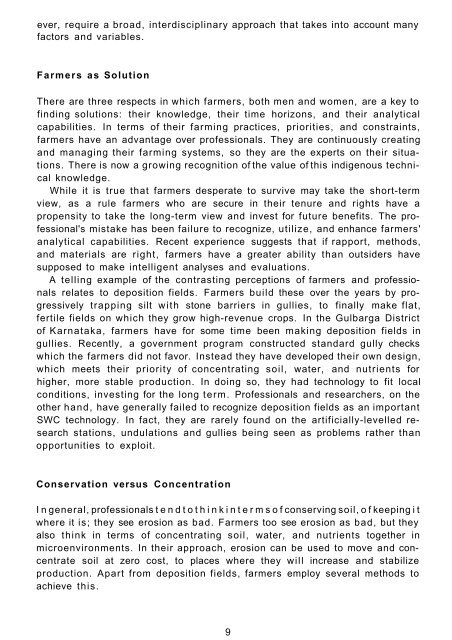Indigenous Practices for Soil and Water Conservation - Agropedia
Indigenous Practices for Soil and Water Conservation - Agropedia
Indigenous Practices for Soil and Water Conservation - Agropedia
You also want an ePaper? Increase the reach of your titles
YUMPU automatically turns print PDFs into web optimized ePapers that Google loves.
ever, require a broad, interdisciplinary approach that takes into account many<br />
factors <strong>and</strong> variables.<br />
Farmers as Solution<br />
There are three respects in which farmers, both men <strong>and</strong> women, are a key to<br />
finding solutions: their knowledge, their time horizons, <strong>and</strong> their analytical<br />
capabilities. In terms of their farming practices, priorities, <strong>and</strong> constraints,<br />
farmers have an advantage over professionals. They are continuously creating<br />
<strong>and</strong> managing their farming systems, so they are the experts on their situations.<br />
There is now a growing recognition of the value of this indigenous technical<br />
knowledge.<br />
While it is true that farmers desperate to survive may take the short-term<br />
view, as a rule farmers who are secure in their tenure <strong>and</strong> rights have a<br />
propensity to take the long-term view <strong>and</strong> invest <strong>for</strong> future benefits. The professional's<br />
mistake has been failure to recognize, utilize, <strong>and</strong> enhance farmers'<br />
analytical capabilities. Recent experience suggests that if rapport, methods,<br />
<strong>and</strong> materials are right, farmers have a greater ability than outsiders have<br />
supposed to make intelligent analyses <strong>and</strong> evaluations.<br />
A telling example of the contrasting perceptions of farmers <strong>and</strong> professionals<br />
relates to deposition fields. Farmers build these over the years by progressively<br />
trapping silt with stone barriers in gullies, to finally make flat,<br />
fertile fields on which they grow high-revenue crops. In the Gulbarga District<br />
of Karnataka, farmers have <strong>for</strong> some time been making deposition fields in<br />
gullies. Recently, a government program constructed st<strong>and</strong>ard gully checks<br />
which the farmers did not favor. Instead they have developed their own design,<br />
which meets their priority of concentrating soil, water, <strong>and</strong> nutrients <strong>for</strong><br />
higher, more stable production. In doing so, they had technology to fit local<br />
conditions, investing <strong>for</strong> the long term. Professionals <strong>and</strong> researchers, on the<br />
other h<strong>and</strong>, have generally failed to recognize deposition fields as an important<br />
SWC technology. In fact, they are rarely found on the artificially-levelled research<br />
stations, undulations <strong>and</strong> gullies being seen as problems rather than<br />
opportunities to exploit.<br />
<strong>Conservation</strong> versus Concentration<br />
I n general, professionals t e n d t o t h i n k i n t e r m s o f conserving soil, o f keeping i t<br />
where it is; they see erosion as bad. Farmers too see erosion as bad, but they<br />
also think in terms of concentrating soil, water, <strong>and</strong> nutrients together in<br />
microenvironments. In their approach, erosion can be used to move <strong>and</strong> concentrate<br />
soil at zero cost, to places where they will increase <strong>and</strong> stabilize<br />
production. Apart from deposition fields, farmers employ several methods to<br />
achieve this.<br />
9

















